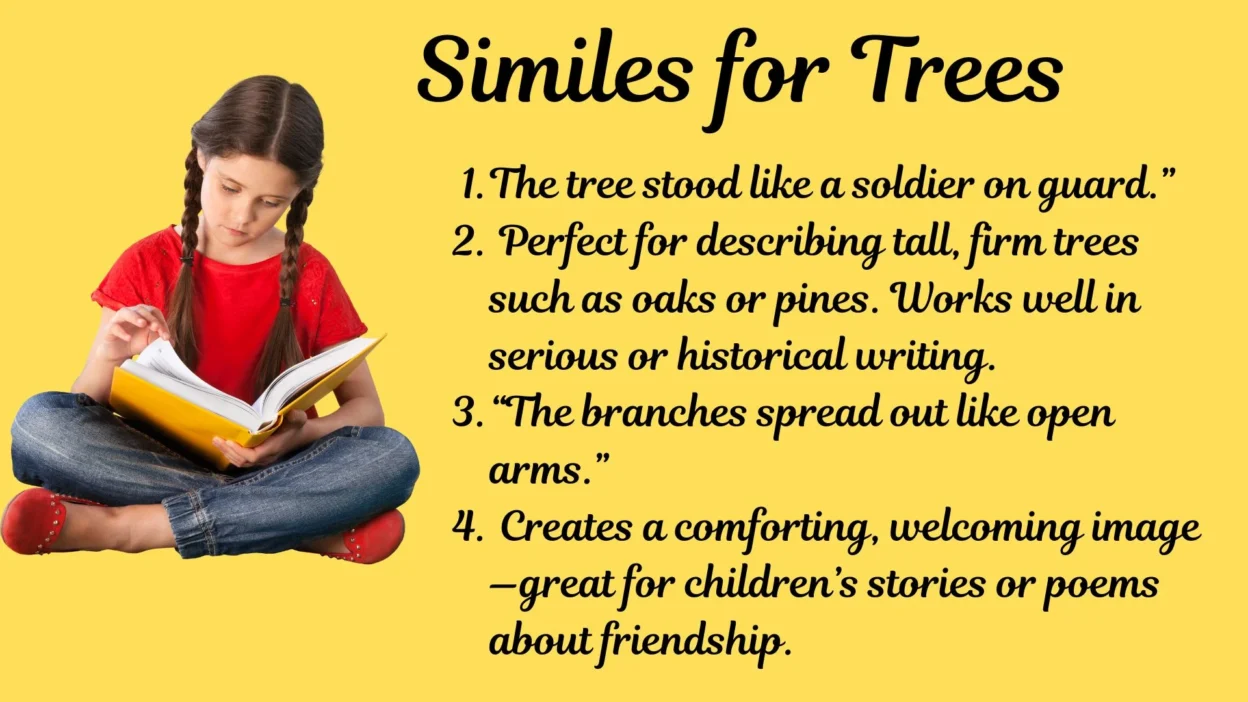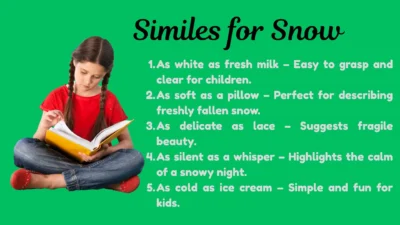Trees have always fascinated poets, writers, teachers, and children alike. They are more than just towering plants; they symbolize growth, strength, and connection to life. But describing trees in fresh, imaginative ways can be difficult—especially for students or writers who want to go beyond saying, “the tree was tall.”
That’s where similes for trees become powerful tools. In this guide, you’ll find 35+ creative similes, complete with explanations, teaching contexts, and practical examples. Whether you’re a teacher looking for classroom material, a parent helping with homework, or a writer seeking inspiration, this article solves your problem with a ready-to-use collection of tree similes and metaphors.
Why Use Similes for Trees?
Similes help readers see ordinary things in extraordinary ways. Instead of saying “the oak tree was strong,” you could say, “the oak tree stood like a soldier on guard.” That image creates emotion, makes writing vivid, and helps children grasp figurative language quickly.
This article gives you a list of similes for trees—short, long, serious, funny, and poetic—so you’ll never run out of creative ways to describe them.
Classic Examples of Similes for Trees
Let’s start with clear, classroom-friendly examples. Each simile is explained in one or two sentences, so learners understand both the literal and figurative meaning.
- “The tree stood like a soldier on guard.”
Perfect for describing tall, firm trees such as oaks or pines. Works well in serious or historical writing. - “The branches spread out like open arms.”
Creates a comforting, welcoming image—great for children’s stories or poems about friendship. - “The leaves shimmered like coins in sunlight.”
Best used in bright, happy descriptions; it brings sparkle and richness to the imagery. - “The tree was like a giant umbrella.”
Easy for kids to understand; describes shady trees in playgrounds or parks. - “The roots dug into the earth like claws.”
Adds a touch of strength and even menace; ideal for fantasy or gothic settings. - “The blossoms were like stars scattered across the sky.”
A gentle, romantic simile—works beautifully in poetry or descriptive essays. - “The bark was rough like an old man’s hands.”
Evocative and relatable; helps young learners make sensory connections. - “The tree swayed like a dancer in the wind.”
Playful and energetic—great for describing lively movement. - “The tree stood like a wise old teacher.”
A personifying simile that adds dignity and wisdom. - “The branches rattled like bones.”
Perfect for eerie or spooky stories; kids love using this for Halloween writing.
Simile for Trees Blowing in the Wind
Wind gives trees movement, making them perfect subjects for similes. Here are some examples focused on that motion:
- “The trees bent like bows ready to fire arrows.”
Strong and dramatic, showing power in nature. - “The branches shook like frightened hands.”
Conveys vulnerability—good for suspenseful or sad scenes. - “The leaves danced like confetti at a parade.”
Fun and lively—ideal for children’s writing. - “The tall pines swayed like ships rocking at sea.”
Brings adventure and rhythm to natural description. - “The tree quivered like a violin string.”
Elegant and musical—use in poetry or romantic writing.
Tree Similes and Metaphors
Sometimes, similes naturally lead into metaphors. Here’s how to expand:
- “The tree was like a lighthouse in the meadow.”
Then turn it into a metaphor: “The tree became the meadow’s lighthouse.” - “The willow wept like a grieving woman.”
As a metaphor: “The willow was a grieving woman.” - “The apple tree was like a treasure chest.”
As a metaphor: “The apple tree held treasures in its branches.”
These examples show children how similes can grow into more advanced figurative language.
Short Similes for Trees
Short similes are quick and effective—perfect for young learners or when writing poetry.
- “Tall as a tower.”
- “Strong like iron.”
- “Green as jade.”
- “Thin like a pencil.”
- “Crooked as a question mark.”
These short versions can be expanded into longer, more detailed comparisons as students progress.
Examples of Similes for Trees with Extra Detail (Standout 10)
Now let’s highlight 10 standout similes with deeper explanations.
1. “The tree stood like a sentinel watching over the village.”
This simile gives the tree authority, suggesting it protects or guards people. Perfect for storytelling where nature feels alive.
2. “The branches spread like a spider’s web across the sky.”
Both beautiful and slightly eerie, this simile suits gothic or mysterious settings. It encourages children to think about shapes.
3. “The leaves fluttered like butterflies in the breeze.”
Gentle and pretty; great for springtime poems or lessons about life cycles in nature.
4. “The tree roots clung like an anchor to the soil.”
Powerful and grounding, showing stability and resilience. Useful in moral lessons about staying strong.
5. “The cherry blossoms drifted down like pink snow.”
A vivid, seasonal simile that helps children connect trees to other familiar images.
6. “The tree’s shadow lay across the field like a blanket.”
Cozy and comforting, perfect for bedtime stories or gentle writing.
7. “The branches cracked in the wind like whips snapping.”
Creates tension and energy—excellent for dramatic narratives.
8. “The tree stood like an ancient monument carved by time.”
Adds grandeur and history; inspires awe in students and readers.
9. “The autumn leaves fell like tears from a tired face.”
Emotional and reflective, ideal for reflective essays or poetry.
10. “The young tree leaned like a child reaching for its mother.”
A tender, emotional simile showing growth, dependence, and innocence.
Personification for Trees
Sometimes, we describe trees with human qualities. This is personification, but similes often lead into it.
- “The tree whispered secrets like an old friend.”
- “The tree bowed like a humble servant.”
- “The branches waved like friendly hands.”
Teaching children both simile and personification side by side helps them master figurative writing more quickly.
Metaphor Examples Connected to Tree Similes
To strengthen understanding, here are a few metaphors inspired by our similes:
- “The tree was a dancer, swaying with the wind.”
- “The forest became a cathedral with trees as pillars.”
- “The tree was a storyteller, its rings chapters of time.”
Extended List of Similes for Trees
Here’s a longer list to ensure variety:
- “The tree swayed like a sleepy child nodding off.”
- “The trunk was straight like a ruler.”
- “The leaves crackled like fire under the sun.”
- “The roots spread like veins through the soil.”
- “The tree leaned like a tired traveler.”
- “The pine needles pricked like tiny spears.”
- “The branches arched like bridges over water.”
- “The tree was like a mother bird sheltering her young.”
- “The dead tree stood like a ghost of the forest.”
- “The blossoms fell like confetti at a wedding.”
- “The bare branches reached like skeletal fingers.”
- “The tree stood like hope in the middle of despair.”
How to Teach and Use Tree Similes
Teachers and parents can use these examples in:
- Creative writing prompts (“Describe the tree in your yard using two similes”).
- Poetry lessons (choose one simile and expand it into a poem).
- Art projects (draw a tree as described in a simile).
- Story starters (pick a simile to open a short story).
This makes similes practical, not just theoretical.
Conclusion
Trees are symbols of life, strength, and beauty—and similes help us capture that in words. By using similes for trees, writers of all ages can make their descriptions more vivid, emotional, and memorable. Whether it’s “branches like open arms” or “roots like anchors,” the right simile can turn ordinary writing into something unforgettable.




